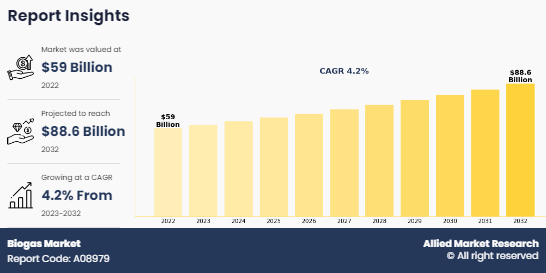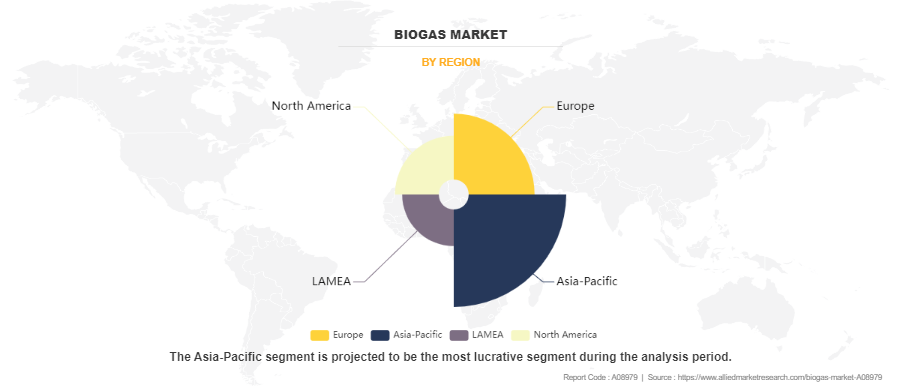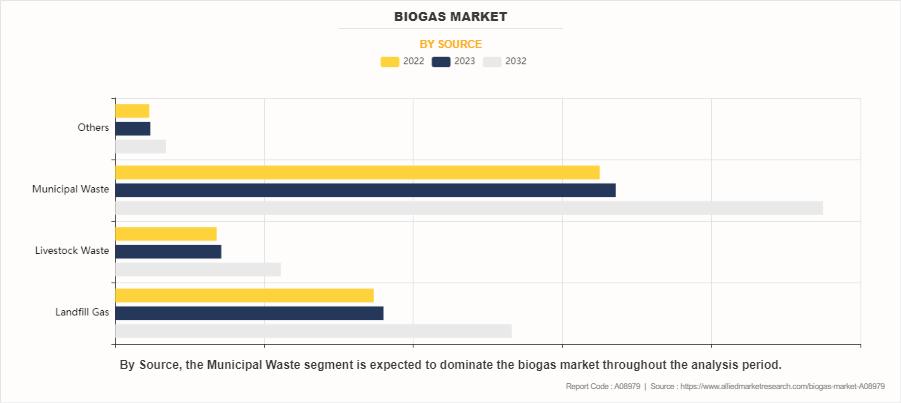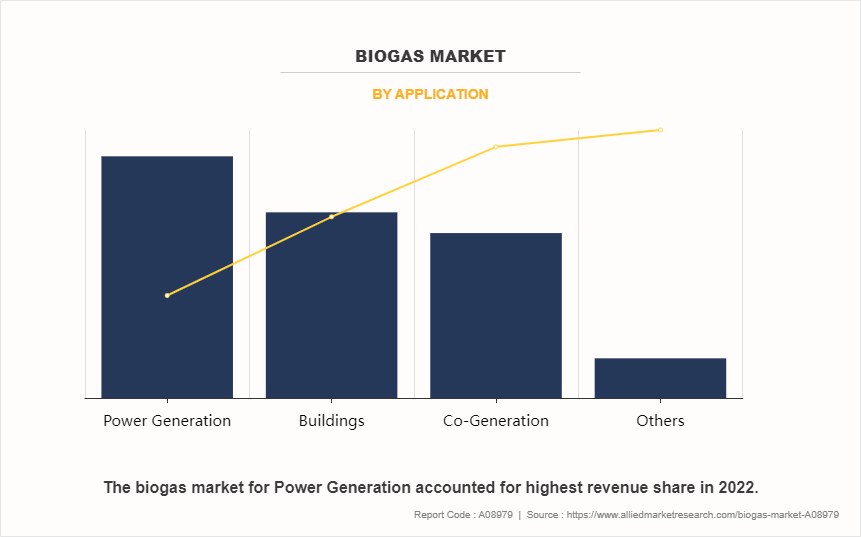Biogas Market Research, 2032
The global biogas market size was valued at $59 billion in 2022, and is projected to reach $88.6 billion by 2032, growing at a CAGR of 4.2% from 2023 to 2032. Biogas is renowned for its renewable nature, versatility, and minimal environmental impact, making it a sought-after energy solution across various sectors. Its applications span electricity generation, heating, cooking, and transportation, with widespread adoption driven by its sustainability, cost-effectiveness, and ease of use. Growing environmental concerns and stringent regulations promoting cleaner energy sources fuel the demand for biogas, while advancements in technology enhance its efficiency and accessibility. Moreover, government incentives and policies supporting renewable energy further boost its market growth.

Introduction
Biogas is a renewable and environmentally friendly gas produced through the anaerobic digestion of organic matter, such as agricultural residues, animal manure, sewage, and food waste. This biological process involves the breakdown of complex organic compounds by microorganisms in the absence of oxygen, leading to the release of methane and carbon dioxide. Methane, the primary component of biogas, is a potent greenhouse gas, and capturing it for energy use helps mitigate its impact on climate change.
Biogas possesses several properties that make it an attractive energy source. It is a versatile fuel that can be used for electricity generation, heating, and as a vehicle fuel. In addition, its production aids in waste management by converting organic waste into a valuable energy resource. Biogas is considered carbon-neutral since the carbon dioxide released during combustion is part of the natural carbon cycle and is offset by the carbon absorbed during the growth of the organic feedstock. Biogas represents a sustainable and efficient solution for both waste management and renewable energy production.
Key Takeaways
- Quantitative information mentioned in the global biogas market includes the market numbers in terms of value ($Million) concerning different segments, pricing analysis, annual growth rate, CAGR (2023-32), and growth analysis.
- The analysis in the report is provided on the basis of source, end-use industry, and region. The study is expected to contain qualitative information such as the market dynamics (drivers, restraints, opportunities), Porter‐™s five forces analysis, key regulations across the region, and value chain analysis.
- A few companies, including Wärtsilä, EnviTec Biogas AG, Air Liquide USA, Hindustan Petroleum Corporation Limited, India, PlanET Biogas Group, BoxLNG Pvt. Ltd., Bharat Biogas Energy Ltd., Primove Engineering Pvt. Ltd., GAIL Gas Limited, and GPS Renewables Pvt. Ltd. hold a large proportion of the biogas market.
- This report makes it easier for existing market players and new entrants to the biogas business to plan their strategies and understand the dynamics of the industry, which helps them make better decisions.
Market Dynamics
The growing agricultural sector demand is a significant driver for the biogas market. As the global population continues to expand, there is an increasing demand for food production, leading to increased agricultural activities. With the rise in agricultural operations, there is a corresponding increase in organic waste generated from crop residues, animal manure, and other byproducts. Biogas technology offers a sustainable solution for managing this organic waste by converting it into valuable renewable energy.
Farmers and agricultural businesses are increasingly recognizing the benefits of biogas production as it provides an additional revenue stream and reduces dependency on traditional energy sources. By installing biogas digesters on farms, agricultural waste can be efficiently processed and transformed into biogas, which can be used for on-site electricity generation, heating, or even as a vehicle fuel. This not only helps offset energy costs but also reduces greenhouse gas emissions, contributing to environmental sustainability. Furthermore, biogas production can enhance the overall efficiency and sustainability of agricultural operations by providing a source of renewable energy for powering farm equipment and facilities. Therefore, the growing demand in the agricultural sector for sustainable waste management solutions and renewable energy sources is expected to drive continued growth in the biogas market.
The growing government support for biogas infrastructure is expected to be a significant driver for the expansion of the biogas market. Governments around the globe are increasingly recognizing the importance of renewable energy sources in mitigating climate change and achieving energy security goals. As a result, many countries are implementing policies, incentives, and funding programs to promote the development of biogas infrastructure.
Government support can take various forms, including financial incentives such as subsidies, grants, tax credits, and feed-in tariffs for biogas producers. Furthermore, governments may invest in research and development initiatives to advance biogas technologies and improve efficiency and cost-effectiveness. By fostering a favorable policy environment and providing financial and regulatory support, governments can stimulate investment in biogas infrastructure and encourage the deployment of biogas production facilities. This leads to increased biogas production capacity, expanded utilization of organic waste resources, and enhanced energy security and environmental sustainability. Thus, the growing government support plays a crucial role in driving the growth of the biogas market by creating favorable conditions for investment and development in the sector.
High initial investment costs pose a significant challenge to the growth of the biogas market. Establishing biogas facilities, including anaerobic digesters, gas upgrading systems, and infrastructure for feedstock collection and distribution, requires substantial capital investment. The upfront costs associated with land acquisition, equipment procurement, engineering, and construction can be prohibitive for many potential investors and project developers, particularly for small-scale and decentralized biogas projects.
Moreover, the complexity and customization of biogas systems further contribute to the high initial investment requirements. Each biogas project must be tailored to its specific feedstock availability, energy demand, and regulatory requirements, adding to the design and development costs. In addition, the need for skilled labor, technical expertise, and ongoing maintenance further escalates the overall investment burden. The high initial investment costs can deter potential investors and limit the scalability of biogas projects, particularly in regions with limited access to financing or where the cost of capital is high. As a result, many promising biogas initiatives may struggle to secure funding or fail to achieve financial viability, thereby hampering the overall growth of the biogas market.
The expansion of renewable energy presents lucrative opportunities for the biogas market. As governments and industries worldwide prioritize the transition to cleaner and more sustainable energy sources, biogas emerges as a key player in the renewable energy landscape. Biogas offers several advantages, including its renewable nature, versatility, and ability to provide reliable energy in a decentralized manner. With increasing concerns about climate change and the urgent need to reduce greenhouse gas emissions, biogas stands out as a viable solution. Its production from organic waste materials helps mitigate methane emissions, a potent greenhouse gas, while also providing a renewable energy source.
Furthermore, biogas complements other renewable energy technologies such as wind and solar power by offering a consistent energy supply that can be stored and utilized as needed. The expansion of renewable energy portfolios creates a favorable market environment for biogas projects. In addition, advancements in biogas technology, such as improved digesters and gas upgrading systems, enhance efficiency and lower costs, making biogas an increasingly attractive investment opportunity in the renewable energy sector. As the demand for clean, sustainable energy continues to grow, the biogas market is poised for significant expansion and development.
According to American Biogas Council, increased domestic investments and renewable energy production drive the growth of the U.S. biogas industry. In 2023, 96 new biogas projects became operational in the U.S., which increased the total number of active U.S. biogas projects to 2,251, which represents $39 billion in capital investment.
Segments Overview
The biogas market is segmented based on source, end-use industry, and region. By source, the market is divided into municipal waste, animal waste, agricultural waste, and others. By end-use industry, it is categorized into electricity generation, cogeneration, and others. Region-wise, the biogas market share is studied across North America, Europe, Asia-Pacific, and LAMEA.

The Asia-Pacific (APAC) region held the highest market share in terms of revenue in 2022, accounting for around two-fifths of the global biogas market revenue, and is likely to dominate the market during the forecast period, growing at a CAGR of 4.5% from 2023 to 2032. The biogas market in the APAC region has been experiencing significant growth due to increasing energy demand, rapid industrialization, growing agricultural activities, and a strong focus on environmental sustainability and renewable energy development. Key countries such as China and India are leading the biogas market growth in the APAC region, driven by supportive government policies, significant biogas potential, and increasing adoption of biogas technology for renewable energy production, waste management, environmental sustainability, and rural development.
By addressing the challenges related to policy and regulatory framework, technology and infrastructure development, and capacity building, awareness raising, and stakeholder engagement, and leveraging the opportunities presented by energy security and diversification, environmental sustainability and climate change mitigation, and economic growth and job creation, the APAC region can unlock the full potential of the biogas market, promote sustainable and renewable energy development, and contribute to the global transition towards a more sustainable, resilient, and low-carbon energy system.

Municipal waste segment accounted for the largest share in 2022, contributing to more than half of the global biogas market revenue, and is projected to maintain its lead position during the forecast period, growing at a CAGR of 3.9% from 2023 to 2032. Municipal waste offers significant potential as a feedstock for biogas production through anaerobic digestion, providing a sustainable and environmentally friendly solution for waste management and renewable energy production. By addressing the challenges related to waste composition and contamination, infrastructure and investment, and policy and regulatory framework, and leveraging the opportunities presented by the abundance of feedstock, environmental sustainability, economic viability, and social and community benefits, we can unlock the full potential of municipal waste for biogas production, promote sustainable waste management and renewable energy production, and contribute to the global transition towards a more sustainable, resilient, and low-carbon energy system.

Biogas is an increasingly popular and sustainable alternative for power generation, accounting for more than one-third of the global biogas market revenue in 2022 and projected to grow at a CAGR of 4.1% from 2023 to 2032. Biogas is produced through the anaerobic digestion of organic materials such as agricultural residues, animal manure, sewage, food waste, and municipal solid waste, offering a versatile and environmentally friendly solution for renewable energy production. By addressing the challenges related to feedstock availability and quality, technology and infrastructure development, and policy and regulatory framework, and leveraging the opportunities presented by the abundance of feedstock, environmental sustainability, energy security and reliability, and economic viability, we can unlock the full potential of biogas for power generation, promote sustainable and renewable energy production, and contribute to the global transition towards a more sustainable, resilient, and low-carbon energy system.
Competitive Analysis
The players operating in the global biogas market are Wärtsilä, EnviTec Biogas AG, Air Liquide USA, Hindustan Petroleum Corporation Limited, India, PlanET Biogas Group, BoxLNG Pvt. Ltd., Bharat Biogas Energy Ltd., Primove Engineering Pvt. Ltd., GAIL Gas Limited, and GPS Renewables Pvt. Ltd. The unique technologies and innovative approaches of the abovementioned companies contribute to the advancement of the biogas market. Other players include Green Elephant, IOT, Praj Industries, and SLPP RE.
Strategic Development by Key Players
- In December 2021, BoxLNG Pvt. Ltd., a clean bioenergy project developer signed a technology collaboration and investment agreement with Netherlands-based HoSt Holding B.V (HoSt) to set up compressed biogas plants in India. Compressed biogas, or CBG, produced by anaerobic decomposition of agricultural waste, sugarcane press mud and municipal waste can be used as a fuel for automobiles.
Key Benefits For Stakeholders
- This biogas market report provides a quantitative analysis of the market segments, current trends, estimations, and dynamics of the biogas market analysis from 2022 to 2032 to identify the prevailing biogas market opportunities.
- The biogas market statistics is offered along with information related to key drivers, restraints, and opportunities.
- Porter's five forces analysis highlights the potency of buyers and suppliers to enable stakeholders make profit-oriented business decisions and strengthen their supplier-buyer network.
- In-depth analysis of the biogas market segmentation assists to determine the prevailing market opportunities.
- Major countries in each region are mapped according to their revenue contribution to the global biogas market forecast.
- Market player positioning facilitates benchmarking and provides a clear understanding of the present position of the market players.
- The report includes the analysis of the regional as well as global biogas market trends, key players, market segments, application areas, and market growth strategies.
Biogas Market Report Highlights
| Aspects | Details |
| Market Size By 2032 | USD 88.6 billion |
| Growth Rate | CAGR of 4.2% |
| Forecast period | 2022 - 2032 |
| Report Pages | 250 |
| By Source |
|
| By Application |
|
| By Region |
|
| Key Market Players | Primove Engineering Pvt. Ltd., EnviTec Biogas AG, GPS Renewables Pvt. Ltd, Hindustan Petroleum Corporation Limited, Wartsila, PlanET Biogas Group GmbH, gail gas limited, BoxLNG Pvt. Ltd., Bharat Biogas Energy Ltd., Air Liquide |
Analyst Review
According to the insights of the CXOs of leading companies, the increasing global emphasis on renewable energy sources and sustainable practices drives the growth of the market. Government incentives, policies, and mandates promoting clean energy solutions, along with the growing awareness of climate change and the need for carbon footprint reduction, fuel the demand for biogas. In addition, stringent environmental regulations and waste management policies contribute to the market's positive momentum, fostering the adoption of biogas technology for organic waste treatment.
However, the biogas market also faces several restraints that hinder its growth potential. One major challenge is the high initial investment cost associated with setting up biogas plants and infrastructure. The capital-intensive nature of biogas projects, including the construction of digesters, gas upgrading facilities, and distribution networks, can deter investors and limit market expansion. In addition, logistical challenges related to feedstock availability, transportation, and storage can pose significant barriers to the widespread adoption of biogas technology.
The CXOs further added that the biogas market presents numerous opportunities for growth and innovation. In the agricultural sector, where the increasing demand for sustainable farming practices and the need to manage organic waste create a favorable environment for biogas adoption. The rising trend of decentralized energy production is another opportunity, as small-scale biogas plants can serve localized communities, reducing transmission losses and enhancing energy security. Furthermore, advancements in biogas technology and ongoing research and development efforts present opportunities to improve efficiency, reduce costs, and enhance the overall feasibility of biogas projects.
The biogas market has been experiencing significant growth due to increasing energy demand, rapid industrialization, growing agricultural activities, and a strong focus on environmental sustainability and renewable energy development.
Power generation is the leading application of Biogas Market.
Asia-Pacific is the largest regional market for Biogas.
The biogas market was valued at $59 billion in 2022, and is estimated to reach $88.6 billion by 2032, growing at a CAGR of 4.2% from 2023 to 2032.
The major players operating in the global biogas market are Wärtsilä, EnviTec Biogas AG, Air Liquide USA, Hindustan Petroleum Corporation Limited, India, PlanET Biogas Group, BoxLNG Pvt. Ltd., Bharat Biogas Energy Ltd., Primove Engineering Pvt. Ltd., GAIL Gas Limited, and GPS Renewables Pvt. Ltd.
Loading Table Of Content...
Loading Research Methodology...


